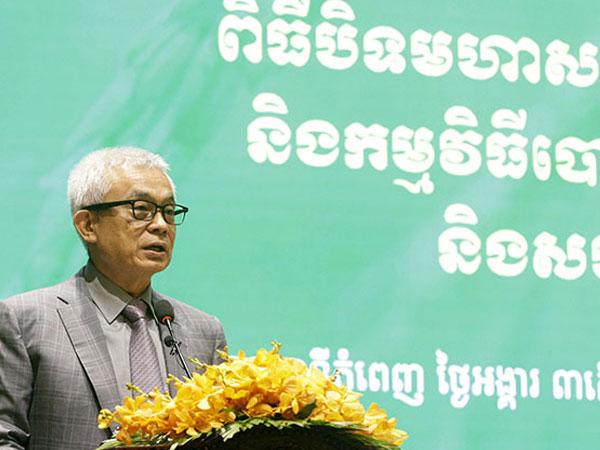 Synopsis: The rice sector is fast evolving and requires all stakeholders to monitor developments and take timely measures to ensure resilience.
Synopsis: The rice sector is fast evolving and requires all stakeholders to monitor developments and take timely measures to ensure resilience.
The Royal Government Tuesday outlined a set of export-focused reforms to stabilise rice prices, safeguard farmer incomes and strengthen Cambodia’s competitiveness amid growing global supply and trade pressures.
Presiding over the official launch of the ‘Cambodia’s Milled Rice Market Expansion and Export Diversification Strategy 2025-2030’, Aun Pornmoniroth, Deputy Prime Minister and Minister of Economy and Finance (MEF), acknowledged the pressures facing farmers, millers and exporters recently, stressing that the rice sector has always been highly dynamic and sensitive to global and regional shocks.
“The situation in the rice sector is constantly evolving and requires all stakeholders to monitor developments closely and take timely, targeted measures to manage risks and ensure resilience,” he said.
The Deputy Prime Minister emphasised that rice prices, which remained high last year due to strong demand and tight supply, have dropped sharply in 2025 as a result of oversupply and shifts in the global market.
“A surge in domestic production, fuelled by farmer expectations of continued high prices, has coincided with the lifting of India’s rice export ban and Pakistan’s resumption of shipments, increasing supply on the world market,” he noted.
He added that the Philippines, one of the Kingdom’s key buyers, also suspended imports for two months, while the closure of the Cambodia-Thailand border further disrupted trade flows.
Pornmoniroth underlined that these developments highlight the vulnerability of Cambodia’s agricultural economy to external shocks and the importance of structural reforms to make the sector more competitive, diversified and resilient.
During his remarks, the Deputy Prime Minister outlined nine strategic measures to stabilise rice prices, strengthen exports and protect farmer livelihoods, calling for coordinated action by the Ministry of Agriculture, Forestry and Fisheries (MAFF), the Ministry of Commerce (MoC) and the Cambodia Rice Federation (CRF).
First, MAFF has been tasked with monitoring market developments closely and deploying intervention mechanisms already established by the government. “MAFF must also strengthen oversight of agricultural inputs, not just yield, to ensure sustainable productivity, he said.
Second, MAFF is expected to promote a wider adoption of digital technologies across farming, procurement, processing and logistics aimed at improving efficiency throughout the rice supply chain.
Third, MoC has been urged to fast-track the implementation of the ‘Cambodia’s Milled Rice Market Expansion and Export Diversification Strategy 2025-2030’ to reduce overreliance on a few markets and position the Kingdom’s rice more strongly in ASEAN, the European Union and beyond.
Fourth, CRF is expected to prepare specific action plans aligned with this strategy and take a proactive role in expanding Cambodia’s export footprint. “Therefore, controlling yield alone is not enough,” he stated.
Fifth, Pornmoniroth emphasised the need to protect farmer livelihoods by ensuring adequate infrastructure for collection and storage during harvests. “Investment in rural warehouses and drying facilities would help absorb supply surpluses, stabilise prices and reduce post-harvest losses,” he said.
Sixth, he stressed that the government and private sector must work together to develop resilient farmer organisations, promote contract farming, and support smallholders in becoming entrepreneurial farmers capable of competing effectively in the market.
Seventh, the branding of Cambodian rice was highlighted as a key priority. CRF has been encouraged to invest more in building international recognition of premium varieties, such as fragrant Phka Rumduol, to sustain export growth and maintain the country’s niche against competitors like Vietnam, India and Thailand.
Eighth, Pornmoniroth recommended building an ‘Actors in a Single Chain’ system to ensure that the interests of exporters, millers and farmers—particularly small-scale producers—are aligned rather than fragmented, strengthening Cambodia’s strategic positioning in the global market while safeguarding rural livelihoods.
Lastly, the Deputy Prime Minister highlighted the role of the newly established inter-ministerial working group, which promotes the exports of priority agricultural and agro-industrial products in Cambodia, operating under the Economic and Financial Policy Committee (EFPC).
He noted that this working group is tasked with proactively assessing risks, coordinating policies and preparing timely intervention packages to support the sector.
“These measures are essential not only to stabilise rice prices and protect farmer livelihoods, but also to reinforce our food security and strengthen its long-term competitiveness in global trade,” he added.














© Copyright 2025 The SSResource Media.
All rights reserved.